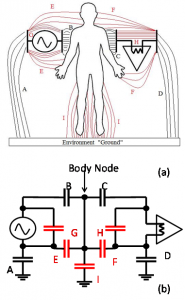Wireless Body-area Networks Using Body-coupled Communication

Figure 1: (a) The electric field lines made between the transmitter, receiver, body, and environment. (b) The circuit diagram for (a); the red capacitors are parasitic and degrade functionality.
Body-coupled communication (BCC) was first implemented at MIT as a means to communicate between multiple devices around the body, forming a body-area network (BAN) [1]. Two-node BCC works by forming two capacitive links between a transmitter and a receiver, creating a circuit loop. One of these links is created by both the transmitter and receiver capacitively coupling to the body, effectively using the body as a low-resistance channel between the respective capacitors. The second link is created by both the transmitter and receiver coupling to the environment, or “earth ground,” and using it as a low-resistance channel. Figure 1 shows how the transmitter and receivers couple to the body and environment as well as parasitic capacitances. Larger BANs can be made by coupling additional nodes to both the body and the environment.
The attractiveness of using BCC as a BAN is that it requires potentially lower transmit power than traditional radio for equal bit error rates. Also, as no appreciable power is radiated away from the body, this scheme does not create interference for other BCC networks on other bodies, making the bandwidth reusable. The lack of radiated power also makes BCC inherently more secure than broadcast radio, as it is harder to intercept the transmissions. Feasibility of BCC transceivers has been shown in [2] and [3]. Our work will thoroughly characterize the BCC channel, develop a robust network scheme, and fabricate the solution.
References
- T.G. Zimmerman, “Personal Area Networks (PAN): Near-field intrabody communication,” M.S. thesis, MIT Media Laboratory, 1995. [↩]
- S.-J. Song, N. Cho, S. Kim et al., “A 0.9V 2.6mW Body-Coupled Scalable PHY Transceiver for Body Sensor Applications,” ISSCC Dig. Tech. Papers, pp. 366-367, Feb. 2007. [↩]
- A. Fazzi et al., “A 2.75mW wideband correlation-based transceiver for body-coupled communication,” ISSCC Dig. Tech. Papers, pp. 204-205, Feb. 2009. [↩]